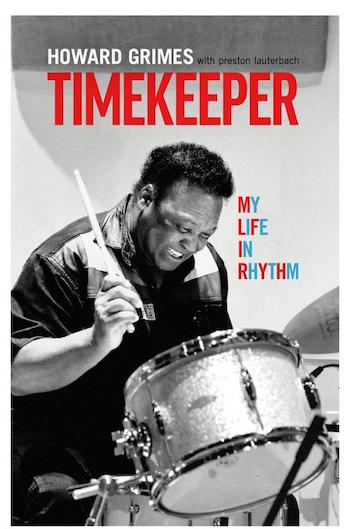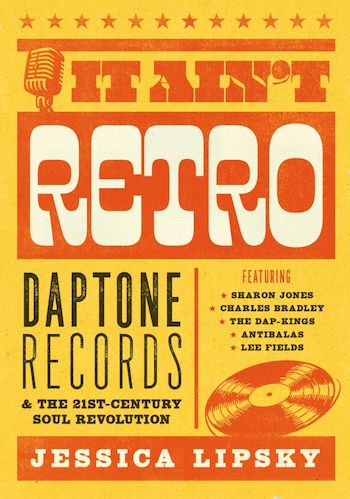Book Reviews: Two Books on Labels That Forged the Soul Revolution
By Noah Schaffer
Howard Grimes’s Timekeeper is the often shocking autobiography of the drummer for Hi Records’ studio house band. It Ain’t Retro is a thorough examination of the Daptone label.
Timekeeper: My Life in Rhythm by Howard Grimes with Preston Lauterbach. DeVault Graves Books, 152 pages $24.95.
It Ain’t Retro: Daptone Records & the 21st-Century Soul Revolution by Jessica Lipsky. Jawbone Press, 296 pages, $22.95.
 Two recent books offer illuminating, behind-the-scenes looks at beloved soul music labels. Howard Grimes’s Timekeeper is the often shocking autobiography of the drummer for Hi Records’ studio house band. It Ain’t Retro may be questionably titled, but it is a thorough examination of the Daptone label, which, four decades after Hi’s reign, became the home for such soul revival acts as Sharon Jones & the Dap-Kings and Charles Bradley.
Two recent books offer illuminating, behind-the-scenes looks at beloved soul music labels. Howard Grimes’s Timekeeper is the often shocking autobiography of the drummer for Hi Records’ studio house band. It Ain’t Retro may be questionably titled, but it is a thorough examination of the Daptone label, which, four decades after Hi’s reign, became the home for such soul revival acts as Sharon Jones & the Dap-Kings and Charles Bradley.
Grimes’s memoirs are a welcome addition to the slew of movies and books that have examined the previously obscure session players who were indispensable presences in the golden era of rock and soul. Many of these testimonies center on the Southern soul made at Stax. Any short list would also have to include the house bands of the Memphis soul labels Stax and Hi, both of which employed Grimes. The Hi Rhythm Section, built around Grimes and the three Hodges brothers, would stand out in soul history just for its contributions to the glory days of Al Green, not to mention classic recordings by the likes of Ann Peebles and Otis Clay.
Timekeeper begins with Grimes’s vivid memories of his childhood. It was a world filled with hustlers and drunks, but there were also musical mentors who could educate a promising young drummer. Grimes would soon become a part of the Memphis club scene, backing not just future soul stars but also outrageous cross-dressing dancers Sissy Charles and Peaches. He appeared on early Stax recordings by William Bell and Carla Thomas. In 1967 he was briefly a member of Paul Revere and the Raiders, who had to request the intervention of Governor George Wallace (!) when a Montgomery venue manager refused to allow a Black musician on his stage. (The infamous segregationist’s children were Raiders fans.)
But what really cemented the drummer, nicknamed “Bulldog” because of his hard-hitting approach, into music history was when he joined the team assembled by Hi producer and label owner Willie Mitchell. Grimes’s unflinching account celebrates the music made by the Hi team, offering valuable insights into the ways small adjustments in the percussion make a big change in the sound. At the same time, Grimes isn’t shy about talking about the challenges that came working with the deeply eccentric Green, the hard partying guitarist Teenie Hodges, and the miserly Mitchell, who gave his studio musicians a measly salary and failed to keep a promise to cut them in when the company was sold.
Without a financial cushion, Grimes found himself destitute and homeless as soon as Hi was purchased and the Al Green sessions ended. Even by the demeaning standards of the music industry, one would be hard pressed to find an example of someone who received so little recompense and credit after having made such immense contributions to popular culture. Even more amazing is that Grimes managed to escape becoming disgruntled or embracing substance abuse. He eventually went back to playing as a member of bassist Scott Bomar’s Bo-Keys, starting with Cyndi Lauper’s Grammy-nominated blues album. Grimes writes that after being mistreated by the industry for so many years he was shocked at the reasonable wage that Bomar paid for session work.
Timekeeper packs a lot of history, insight, and emotion into its pages. It’s a fast but essential read for anyone wanting to know how the magic of Memphis soul was created.
 By the start of the millennium, many soul fans were bemoaning that the gritty and impassioned soul made at labels like Hi had dropped out of favor, replaced by the more nuanced and slick sounds of the neo-soul movement, which at the time was at its creative and popular peak. In response, a few devoted musicians, producers, and label owners in Brooklyn started to put out a small batch of 45s that sounded as if they had been made decades earlier. Within a few years, the Daptone label’s marquee acts had become regulars on late-night television shows and major festival stages. Soon, these musicians were in constant demand for session work, perhaps most famously on Amy Winehouse’s breakthrough soul revival LP Back to Black.
By the start of the millennium, many soul fans were bemoaning that the gritty and impassioned soul made at labels like Hi had dropped out of favor, replaced by the more nuanced and slick sounds of the neo-soul movement, which at the time was at its creative and popular peak. In response, a few devoted musicians, producers, and label owners in Brooklyn started to put out a small batch of 45s that sounded as if they had been made decades earlier. Within a few years, the Daptone label’s marquee acts had become regulars on late-night television shows and major festival stages. Soon, these musicians were in constant demand for session work, perhaps most famously on Amy Winehouse’s breakthrough soul revival LP Back to Black.
Unfortunately, Daptone stars Jones and Bradley both passed away in their 60s, while Dan Klein, front man of the label’s Queens, NY, band, The Frightnrs, passed away from ALS at 33. Daptone is still active today, releasing everything from Moroccan gnawa to L.A. Chicano soul, but its current 20th-anniversary celebration has a bittersweet tinge to it: the focus is on issuing archival performances by artists who are no longer with us.
Jessica Lipsky’s well-written It Ain’t Retro captures the highs and lows of the label’s heyday, concentrating on how a cast of older Black singers, like Jones, Bradley, and Lee Fields, found themselves collaborating with young hipster musicians a fraction of their age. The early days of Daptone featured a dizzying array of interconnected bands but Lipsky manages to deftly move the story along without becoming mired in minutiae. She is also good at portraying the personalities of the musicians: the sweet but tough Jones, the shy and spiritual Bradley, and the straight-shooting bassist, producer, and label honcho Gabe “Bosco Mann” Roth. Also admirable: a thorough look at how the ’60s soul-loving community of DJs helped pave the way for the Daptone era. (The crew behind Boston’s “DJ Night: Soulelujah” energetically spread the word when Lee Fields and the Sugarman Three as well as Jones and the Dap-Kings played pre-fame shows at Cambridge’s TT The Bear’s and the Middle East.)
But while Lipsky’s writing chops are impressive, she never quite explains why Daptone’s musicians reached heights that so few other revival bands could match. Yes, the Daptone records were great. But soul vets like Charles Walker, Marva Whitney, Sonny Knight, and Ural Thomas — most of them sporting more impressive discographies than either Jones or Bradley — all recorded and toured with young bands during the same period. None came close to achieving the popularity of the Daptone acts. What sets Daptone apart in terms of creativity or marketing? We never get an answer. Given that Lipsky is a prolific music journalist who frequently covered Daptone releases, she was in an ideal position to detail the workings of Daptone’s well-oiled PR machine.
The book also largely punts on the complex issues of race that are detailed (and often debated) in most soul music histories. There are just a few paragraphs devoted to the matter, most of them quotes from an interview with Dap-Kings guitarist Binky Griptite. The implication is that listeners outside of the largely white NPR crowd probably first encountered Daptone-affiliated efforts without realizing it, via Jay-Z tracks, movie soundtracks, or the Broadway hit Fela, which featured members of Antibalas.
Perhaps the most irritating part of Lipsky’s book is that it refuses to acknowledge that, far from dying out after the heyday of Motown and Stax, soul music was kept alive by Southern Black audiences on the so-called chitlin’ circuit, which developed into today’s still vibrant Southern soul scene. That area is examined by two other recent books, The Last Soul Label, Rob Bowman’s authorized history of Malaco Records, and I Ain’t Studdin’ Ya, artist Bobby Rush’s memoirs. Yes, Southern Soul uses more updated production techniques than the proudly analog Daptone crew, but it’s still soul music. The opening scene in It Ain’t Retro takes place at a New York Daptone package show, which Lipsky claims is the first time “in decades” anyone had attempted a big soul revue. In reality, such affairs take place every single weekend in Black Southern venues. It’s a particularly frustrating omission because Lee Fields was a Southern soul star (and a European dance music artist) before he became a soul revival darling. Bradley maintained a parallel career that found him singing in hipster rock clubs all week before doing his Black Velvet James Brown show for a mostly Black audience at Brooklyn’s Essence Bar every Sunday.
Although the book is largely sourced on interviews with key Daptone players like Roth and Newton native Neal Sugarman, It Ain’t Retro is an unsanctioned homage; it is not mentioned in any of the PR for Daptone’s current 20th-anniversary celebration. Because of that, Lipsky ends up having to describe Daptone album covers — none are present in the volume’s small photo section. But even if the book is unauthorized, that doesn’t explain why it is missing a discography, which is an invaluable element in the history of any label, especially one with such an interrelated web of musicians.
Bottom line: a super fan of Daptone will find the book interesting, particularly the details about the label’s early days. But those seeking a lively introduction to the Daptone story might be better off checking out the excellent films about Jones and Bradley.
Over the past 15 years Noah Schaffer has written about otherwise unheralded musicians from the worlds of gospel, jazz, blues, Latin, African, reggae, Middle Eastern music, klezmer, polka, and far beyond. He has won over 10 awards from the New England Newspaper and Press Association.
Tagged: Daptone, Howard Grimes, It Ain’t Retro, Noah Schaffer, The Hi Rhythm Section

[…] Book Reviews: Two Books on Labels that Forged the Soul Revolution artsfuse.org […]